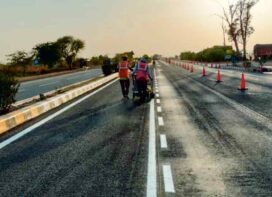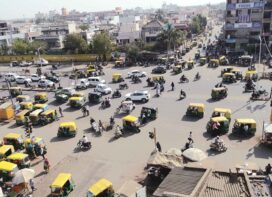The key elements of the driving process are driver, vehicle, and driving environment in which the driver plays the pivotal role. The human eyes provide vital information about visual behaviour. Studying the driver’s gaze behaviour is important to improve driving safety conditions and, consequently, to enhance the general traffic safety. An analysis by Dr. A Mohan Rao, Senior Principal Scientist, Kamini Gupta, Senior Technical Officer and Dr. Neelima Chakraborty, Senior Principal Scientist, Central Road Research Institute, New Delhi.

L-R: Dr. A Mohan Rao, Kamini Gupta, Dr. Neelima Chakraborty
The process of eye tracking involves discovering the presence of eyes and a precise interpretation of eye positions. The position of the eye is generally measured with the help of the pupil or iris center. Gaze estimation is a process to estimate and track the 3D line of sight of a person, or simply, where a person is looking. The device or apparatus used to track gaze by analyzing eye movements is called a gaze tracker.
Driver Gaze
Studying the driver’s gaze behaviour is important to improve driving safety conditions and, consequently, to enhance the general traffic safety. Gaze control may involve movements of eyes, head and trunk, and these are coordinated in a way that can be translated, more or less directly, into motor control signals for the arms. The eye gaze is the forward field of view, at the expense of the peripheral field of view. Gaze concentration is measured as an increase of the percentage of eyes-on-road time during a secondary task.
Segmentation of Driver’s Field of View
Driver’s vision area or Field of View, also referred here as Area of Interest (AoI) is a vital part of the research as it allows classifying gazes on basis of their purpose through defining particular areas. AoI addresses the over attentional and under attentional behaviour of the driver. We have divided our area of vision into nine Areas of Interest based on the necessities of gaze of a driver.
- Frontal vision (FV) is the most effective and dominating portion in field of view of the driver where he most frequently looks and is supposed to concentrate in this particular region. It includes the gaze on road ahead along with vanishing point. Based on studies it is best suited to have the Frontal Vision portion in shape of Rectangle extending to a 16-24 Degrees of the Field of View. For Accurate representation of swiftly occurring changes in field of view, the FV has been associated with a width on the steering wheel which is nearly about 24-28 degrees of the Field of View.
- Right side mirror (RSM) represents the area covered by the side mirror on right and plays a vital role in avoiding side-on collisions
- Left side mirror (LSM) represents the area covered by the side mirror on Left and plays a vital role in avoiding side-on collisions
- Rear view mirror (RVM) represents the area covered by the rear-view mirror and have a significant role in avoiding rear-end collisions
- Odometer (ODO) represents the portion of steering wheel where driver generally gazes on the odometer to notice his current speed, other important instructions and driving assists on odometer.
- Stereo portion (STE) is the portion around the Odometer region including stereo, in-vehicle assists, passenger, dashboard, etc., It is the dominating source of in-vehicle distractions contributed by various factors leading the driver to look into this portion.
- Strip above frontal vision (SAFV) is the portion above the FV which often includes the region above vanishing point and with the changes in field of view incorporating the dashboard above the windshield.
- Right portion except the mirror (RPEM) is the portion on the right side of the field of vision other than the RSM Portion. It generally comprises the distractions and attentions on the rightward side such as median, signs and crossing pedestrians & vehicles.
- Left windshield portion (LWP) is the portion on left side of the field of view and generally accommodates the dominating sources of distractions.
Data was collected and analysed using Tobii Pro Glasses 2, head mounted device which gives a visual field of view of 82 degrees horizontal and 52 degrees vertical. Areas of Interest and Time of Interests were created to identify the changes in gaze behaviour of the driver with changes in road sections. IVT Filter was used to classify the gaze movements with threshold of 30 degrees per second.
The data collected on 4 and 6 lane roads are analysed and also the results of driver visions in different AoIs in-terms of the total time in seconds and percentage of gaze visit and gaze fixations on different AoIs.
The gaze visit summary shows that the dominating AoI is Frontal Vision (FV) varying from 93 to 95 percent, which is often incorporated in various literatures as Field of View on the road centre and is expected to have most of the concentration accumulated inside it. The decrease in proportion of gaze visits in the frontal vision will lead to increased distractions of the drivers.
On 6-lane road, the FV is reduced (93.7%) compared to 4-lane road. It indicates that the drivers are getting distracted more on 6-lane roads. Similarly, the visits in RPEM for 6-lane road is also more, this value should be as low as possible as they are general sources of the distractions to driver. The visits to the mirror areas such as, RSM, LSM and RVM shall also be significant to allow the driver to be alerted of his surroundings, and be able to avoid or mitigate any possible or potential conflict. Driver should visit ODO areas to adhere to the posted speed limits.
Impact of Driver Gaze Visit on Road Geometry
Driver Gaze and Area of Interest
Road geometry– straight section, intersection and curves– have significant impact on the driver gaze pattern. The study of the impact of driver gaze with respect to different road geometry shows that the gaze visits on the mirrors (LSM, RSM and RVM) significantly decrease on the curve and intersection sections as compared to straight sections. The intersection values are slightly more than the curve sections.
The drivers are concentrating on all AoIs while driving on straight sections. While driving at intersections, the driver is alert about his surroundings and tends to watch ahead of him but in a much more scattered manner as there is not much need to focus ahead of him; the driver has only 90 percent frontal vision areas. At intersections, the driver gaze is spread across AoIs such as LWP and RPEM. This is due to the fact that a driver has to stay much more focused on the road ahead of him while manoeuvring on road curves and so his main area of attention is dominated by frontal vision (around 97%).
Gaze Concentration on Different Road Geometry
Driver’s Gaze is an important parameter relating where the driver is looking at and how he is able to perceive and react to the information he is able to receive. Gaze pattern or gaze behaviour generally varies with road geometry such as curves, intersections, bus stops, bridges, toll plazas, roundabout, etc. The driver gaze observed on different road geometry of the selected study corridors are analysed to find out how the driver is navigating his vision on different road geometry; sequence and duration of fixations are analysed, and the concentration of gaze is understood by preparing heat maps. The driver gaze and heat maps of different road geometry are shown in figure.
The visual patterns on straight sections, intersections, and left and right curves are very different. Since the gaze behaviour, when driving on straight sections is characterized by an accumulation of fixations on non-traffic-relevant road elements, the driver’s gaze on straight lines is almost evenly distributed over the entire width of the road and is even aligned towards the sky.
The results of the gaze analysis shows that the numbers of fixations on straight sections to the left (20.6) and right (79.4) of the main visual axis are not the same as per the literature review that indicates the driver behaviour separate as compared to developed countries. Similarly, the gaze concentration above centre line (CL) is 80.2 percent and below the CL are about 19.8 percent.
It can be observed that the below CL gaze (19.8%) is the in- vehicle distraction. The percent fixation durations are more in right and below CL as compared to the number of fixations. The gaze concentration at intersection is 72.7 percent on right side; being only 0.5 percent below the CL means the driver is fully attentive at intersections. Interestingly, the driver gaze at left curve is 100 percent right and above the CL, whereas at right curve, 61 percent is on right side. At toll plazas, about 75 percent gaze is on right side, and only about one percent in vehicle distractions is observed.
Relation between the Accidents type and AoIs Gaze visit of the driver
From the road accident data report provided by MORTH (in 2018 & 2019), it is seen that the hit from back (rear – end collision) accidents are increasing (20%) on a concerning rate. To overcome this type of accidents, the driver should have the habit of using rear end mirror. The study finds out that, gaze visits into the rear view mirror (0.05% on 4-lane road and 0.88% on 6-lane road), is insufficient to reduce the chances of rear end collisions and it is due to unawareness of the driver about the situations behind the vehicle. Similarly, accidents caused due to side collision is around 12%. In the present study, it has been observed that the use of side mirror gaze by drivers varies from 0.20 to 0.25. It is also very nominal. To avoid this type of accidents, the driver should be educated to increase the gaze concentration in these Areas of Interest.
Pupil dilation on Road Geometry
Pupil diameter represents the cognitive distraction as a cognitive function of the mind of the driver. Pupil dilates significantly when a person fixates on particular point or when he is under excessive stress. Various studies have established stress equations with the change in pupil diameter, standard deviations of pupil diameter or pupil dilation extreme values.
While driving through curve section, the driver is sure that the interference of driving is low; hence he is concentrating on road sections only. Hence, the results of curve sections show that the drivers have low stress during driving on curve sections. At the intersections, during the wait, driver mostly fixates on signals and crossing vehicles or pedestrians that leads to higher fixation times in terms of gaze. As a result, driver pupil size leads to dilate (2.08 mm) and concentration level increases on fixated objects for majority of the time.
It has been observed that the stress level reflected by the pupil dilation is highest for Odometer (2.36) followed by shops along the route (2.02). These two elements are the major sources of distraction and they are implying higher level of cognitive load on driver with increased pupil dilation. Traffic signs, traffic control devices and parked vehicles are attention-grabbing objects, which have also higher pupil dilation due to the focus driver needs to put on them to analyse and assess the situation. Pedestrian and road markings have lowest pupil dilation as the occurrence of fixation of these is quite rare and is only for a very small proportion of time due to which driver is not able to generate that amount of cognitive load.
Preview Distances
Preview distance is the distance from which an object or element is visible to driver and the driver can perform required action to accommodate/adopt to the situations. Preview distance also varies with the understanding level of the driver and the vision parameters of the individual driver and the element itself of the road where driver is observing.
While studying preview distances for follow up car and traffic signs and signals, the range is more on four lane roads. It may be due to fewer carriageways and the driver is concentrating more on road furniture.
Results
Three runs were carried out on Faridabad – Gurgaon road which is a 4-lane urban arterial divided road passing through Faridabad-Gurgaon Toll Plaza. Also there were six runs on NH-48 Delhi-Gurgaon Road through Kherki-Daula Toll Plaza from 38.00km-44.00km stretch, through two working days with different drivers and an intermediate span of 1 month in between to take into account changes in traffic characteristics. Data was analysed using Tobii Pro Glasses 2; all parameters like Blink, Pupil Diameter, Head Position, Gaze Coordinate were extracted using software with 100 Hz HD recording of 1920X1080 resolutions.
Different eye movements in AOIs were observed stating the dominating portion of FV in Field of View of an experienced driver. Curves have been identified as the critical section where driver tends to fixate as low as possible to manoeuvre the section safely. It also infers that the curve should be free of attention-grabbing elements which do not play significant role in assisting the driver. It has been observed that the shops and hoardings on route provide significant cognitive workload on the driver which is suggested by the pupil dilation while fixating on them. The preview distances on 4-lane road comes to be higher than the 6-lane road for most of the fixations due to availability of most elements nearer to the Field of View in 4-lane road compared to 6-lane road due to the acuter angle formation on 4-lane road.
Further study shows that the average blink duration and average fixation duration significantly decreases on curve and hence justifies the higher risk factor on curves for the driver. Further study of gaze concentration could be used as a measure of decision making glances during the lane choice at toll plazas.
 TrafficInfraTech Magazine Linking People Places & Progress
TrafficInfraTech Magazine Linking People Places & Progress



